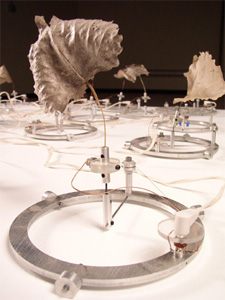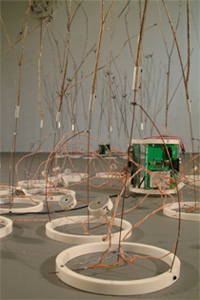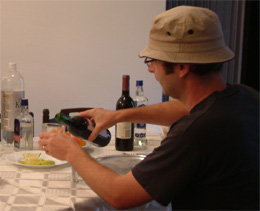 I recently spotted on rhizome the work of a young artist called David Bowen. His growth rendering device provides light and food to a plant in the form of hydroponic solution. The plant reacts to the device by growing. The device in-turn reacts to the plant by producing a rasterized inkjet drawing of the plant every 24 hours. After a new drawing is produced the system scrolls the roll of paper four inches so a new drawing can be produced during the next cycle. I found it so charming i decided to ask him a couple of questions about the piece. It rapidly evolved into a full-fledged interview.
I recently spotted on rhizome the work of a young artist called David Bowen. His growth rendering device provides light and food to a plant in the form of hydroponic solution. The plant reacts to the device by growing. The device in-turn reacts to the plant by producing a rasterized inkjet drawing of the plant every 24 hours. After a new drawing is produced the system scrolls the roll of paper four inches so a new drawing can be produced during the next cycle. I found it so charming i decided to ask him a couple of questions about the piece. It rapidly evolved into a full-fledged interview.
Bowen is interested in the outcomes that occur when machines interact with the natural world. Although he has only received an MFA degree from the University of Minnesota in 2004, he has already exhibited internationally and is currently Assistant Professor of Sculpture at the University of Minnesota, Duluth.
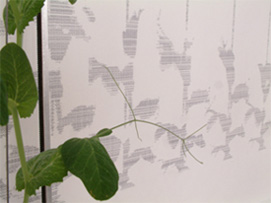
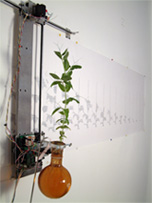 Growth rendering device
Growth rendering device
Where does your interest for devices, machines and other systems come from?
As a kid I was always taking things apart to see how the worked. When I got older I began to be attracted to machines as formal objects. I am fascinated by the beauty of systems and machines how their shapes, movements and compositions are determined by their intended function. I became interested in steel and kinetic sculpture as an undergrad. My interest in kinetic sculpture flourished as a grad student at the University of Minnesota, Minneapolis under the guidance of my mentor Guy Baldwin and the time I spent working with the Mechanical Engineering Department.
Some of your devices look delicate, almost fragile. What governs their appearance?
Many of the forms I construct arise from the function they are intended to perform. If a device uses wind to produce a mark on paper then it should logically be delicate and light in order for the wind to articulate it. In a composition of multiple units the individual devices are given more freedom to move and interact if the are constructed from light weight materials. I used to work with steel but I discovered that manipulating steel is very hard your tools and body, and heavy objects are much more difficult to articulate. Formally plastics and aluminum create a greater contrast with natural forms, movements and systems.
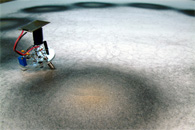
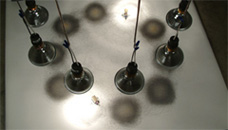 Phototropic drawing device
Phototropic drawing device
I’m particularly intrigued by the Phototropic Drawing Device. How did you come up with the idea? What were the challenges you encountered while developing it?
Phototropic drawing device came after a piece entitled 50drones in which 50 individual units where intended to create organic compositions. The drones where tethered with wires in order to give them power. The phototropic device came from the desire to create a more autonomous device.
In many ways the devices are living things they are powered by and attracted to the nearest most intense light source. They will even detect and respond to the ambient light in a room. When they are not in use I must place the devices solar cell down on my desk, otherwise the will work their way to the edge and commit suicide.
Early experiments with the devices involved setting groups of them near pools of light and allowing them to work their way toward the light, observing the compositions which occurred as the devices attempted to displace one another. This could only go so far because the devices would jumble up and no longer move. The addition of the charcoal and paper allowed a single device to produce a drawing based on its search for food.
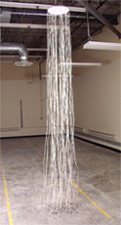
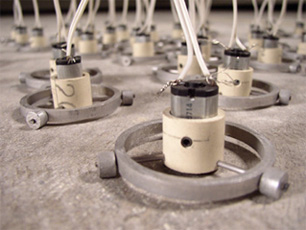 50drones
50drones
Do you feel that the drawings made by your interactive drawing devices belong to you in a certain way or do you feel that the drawings are made at 100% by the devices? Why? Do you regard each of drawings as pieces of art or is it the process of the drawing that constitutes the artistic component of the work?
I believe the drawings are sort of collaboration between myself, the device and, in the cases of interactive devices, the participants. The drawing devices I construct collect highly qualified data based on it’s construction and the way it and the participant respond to the situation. In many cases the drawings on their own are beautiful formal objects, and I do sell/exhibit them on their own. But I feel there needs to be an awareness of how they where created through didactic, video or ideally seeing the device itself in action.
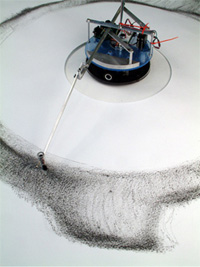 Your pieces are very lively. They interact with natural elements, sensors, other devices, people passing through the exhibition spaces, etc. They seem to have some kind of independent life and you’re not part of it. They don’t need you anymore. Is my rapid analysis too superficial? How much free will and independance from you do these devices really have?
Your pieces are very lively. They interact with natural elements, sensors, other devices, people passing through the exhibition spaces, etc. They seem to have some kind of independent life and you’re not part of it. They don’t need you anymore. Is my rapid analysis too superficial? How much free will and independance from you do these devices really have?
See previous answer…. In many cases I after creating the device and system I step away and let it do its thing. For example I set up phototropic drawing device in my studio and let it draw. I can go have a sandwich and it’s still drawing… I can go teach a class and it’s still drawing… one of the drawings featured on my website was produced over four months of continuous drawing. One of my pieces titled sonar drawing device is drawing in the Tweed Museum of Art as I type. The do at times need fresh charcoal or crayons but the do function with relative autonomy.
Many of your pieces feature several units. 50drones, for example, “consists of 50 aluminum and pvc units connected to 10′ tethers. Each unit moves independently as they displace and arrange one another in random and unpredictable patterns.” What do you see as interesting in objects moving in groups?
“50 drones” came from a desire to eliminate the literal natural form like a twig or leaf, as used in previous pieces, in favor of emulating a natural behavior. The device could be seen to represent a crowd of people a school of fish or particles in a state of disbursement.
What did you try to achieve with Growth Rendering Device? What did you learn by observing this intimate relationship between a plant and a machine?
With growth rendering device I wanted to create reciprocal relationship between a natural object and a mechanical system. The piece is still very new so I continue to observe. But I find it interesting when mechanical systems, motors and micro-controllers behave in unpredictable ways where plants have the tendency to grow in very systematic mechanical ways.
Who are the artists whose work inspires you and why?
I am influenced by many past artists you would expect like Jean Tinguely, Arther Ganson and Cy Twombly for their use of kinetics both literally and through mark making. I am of course influenced contemporary people working with technology like Edwardo Kac, Stelarc, Simon Penny and Natalie Jeremijenko because the address technological elements as materials and utilize technology to integrate mechanical systems with the natural world.
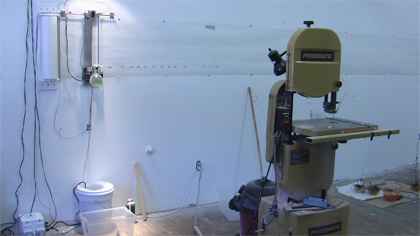 David Bowen’s studio
David Bowen’s studio
Any upcoming projects you’d like to share with us?
I have an upcoming exhibition at the Rochester Art Center in Rochester, MN opening May 19th. The exhibition will feature “growth rendering device” which will produce a 50 foot scroll drawing of a pea plant as it grows over the three month exhibition. I was awarded a full fellowship to attend the Vermont Studio Center this June and I was awarded a fellowship to attend The Bemis Center for Contemporary Art in June, July and August of 2008.
Thanks David!

